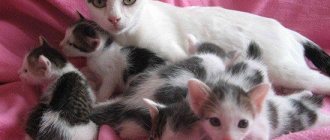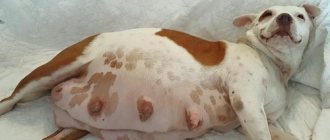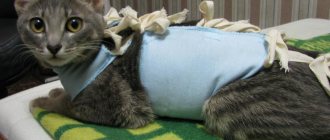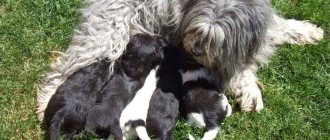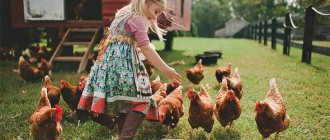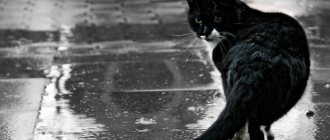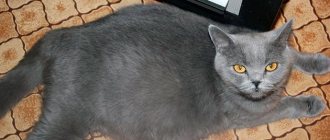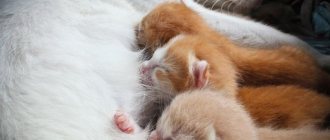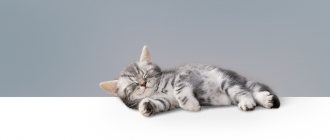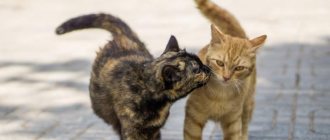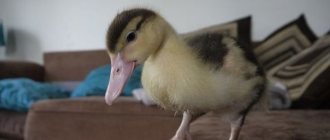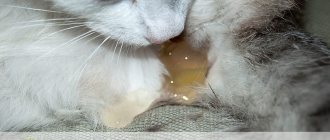What will you learn from the article?
- Ready-made food for nursing cats Acana Wild Prairie
- ProNature Holistic For adult cats (1+) “Duck with orange”
- Bosch Sanabelle Kitten
- Eukanuba Kitten Healthy Start
- 1st Choice "Healthy Start" for kittens
- Hill's Science Plan Optimal Care
- Protein products
- Walnut infusion
I think you will agree that pregnancy and feeding kittens is an important period for every mature cat. Some owners think about what to feed a nursing cat even at the moment when they first find out that she is in an “interesting situation.”
Most people decide on specialized nutrition for their furry pet after the kittens are born. One way or another, a nursing cat must have a special diet, because she needs not only to recover after giving birth, but also to feed her offspring. From this article you will learn which dry food is best for a cat after giving birth, their advantages and disadvantages, as well as the features of feeding natural food and methods of stimulating lactation.
The cat's appetite wakes up a day after giving birth, but this can happen earlier or later: a lot depends on age, health, body weight, number of kittens and other factors. Within a few days after the birth of the offspring, the portion should be increased 2-3 times.
A nursing cat needs a balanced and nutritious diet without artificial chemical additives!
It is best to purchase ready-made specialized food for cats after birth, because they are specially designed to meet the needs of the animal during lactation.
General recommendations
Newborn kittens cuddle with their mother almost every two hours . Together with milk, they “suck” calcium, vitamins, and a lot of microelements from the nurse. Due to this, they grow and develop. But in order for mother not to lose weight and not lose her beauty, she must constantly make up for all these losses. This can only be done through a special diet - enhanced and balanced. Therefore, the food of a nursing cat should be rich in proteins, fats, carbohydrates, and rich in calcium, minerals and trace elements.
This is interesting! The cat actively feeds her kittens until about 2 months of age. At this time, she spends 3-4 times more energy than usual.
During lactation, the cat is fed frequently and in small portions. Essentially, her feeding pattern becomes similar to that of kittens. His main principle at this time is to provide the mother with regular replenishment of energy reserves so that she does not feel hungry. But food should not only be nutritious, but also varied, easily digestible, enriched with vitamins and contain a sufficient amount of liquid.
Healthy eating rules
The rules for healthy cat nutrition before and after birth are similar. Only small adjustments are needed to take into account the peculiarities of the new status - a nursing mother.
Nutrition during this period has 3 tasks.
- Restore the animal's strength after birth.
- Stimulate milk production.
- Match the increased energy expenditure during the feeding period.
Moreover, the nutritional value of the food should be such that it is enough to replenish the body’s reserves for future pregnancies. And although this is achieved not only by increasing the volume of food, it is the volume that needs to be adjusted first.
The serving size and total daily ration during the feeding period depend on three factors.
- Litter quantity.
- The animal's own weight.
- Age of the animal.
Important! On average, it is believed that a lambing cat needs 2 times more food.
It has been noticed that some cats do not eat well immediately after giving birth. Their taste preferences often change. They refuse their usual food and begin to enjoy eating raw fish and drinking milk, which they had previously resolutely refused. Owners should be understanding about such “zagidons”, trying to add more variety to the nursing mother’s diet so that the animal’s appetite is always at its best.
The first two weeks after childbirth, the nurse's menu is made up of easily digestible foods - milk, cottage cheese, vegetables, cereals and boiled lean meat. The second half of the feeding period is marked by a transition to “usual” foods.
The diet becomes more meat and fish. Throughout active lactation, the cat needs plenty of fluids and increased replenishment of calcium and magnesium. Their deficiency is fraught with problems with teeth, joints, and hair in a nursing mother.
As a result, the proper nutrition of a nursing cat will be determined by its appearance and weight after this important and stressful stage is completed. Ideally, after the kittens gain independence, the animal should weigh the same as it weighed before pregnancy and look no worse. And well-fed, healthy offspring will frolic nearby.
Natural nutrition
The diet of a nursing cat can consist of both special industrial food and dishes prepared by the owner himself. If in ready-made food all the proportions have already been verified and balanced by the manufacturer, then, with natural nutrition for the ward, its owner will have to perform these tasks himself.
There are several rules for natural nutrition of a nursing cat:
Stimulation of lactation.
- During the first 25 days after birth, a cat's milk is intense. Then its quantity decreases. Sometimes, even with good nutrition, it is not produced enough. Therefore, we need products that stimulate lactation. These are usually milk and broths. For greater effect, they add decoctions of herbs - anise, lemon balm, oregano - a teaspoon in the morning and evening. You should take into account the cats’ delicate sense of smell and make a decoction of low concentration (1 teaspoon of herb per 3 cups of boiling water). The broth should not be bitter.
Freshness and naturalness.
- All products must be fresh and free of chemical additives.
The presence of protein products in the diet.
- These are sea fish, chicken, turkey, beef, liver, eggs. All this is given boiled.
Presence of carbohydrate components.
- They are provided by cereals in the form of porridges. Buckwheat, oatmeal, and barley cereals are good.
Dairy products.
- Cottage cheese, goat's or cow's milk - they should make up at least 1/3 of a nursing mother's menu and be given 3 times a day.
Vegetables.
- They are added in a crushed state to porridge soup that has cooled to room temperature. Suitable for these purposes: pumpkin, lettuce, cucumber, Chinese cabbage, carrots, broccoli, cauliflower. Problems may arise if the animal has not previously been accustomed to vegetables. Refusal of vegetables is a reason to grind them in a blender and try to start mixing them into food, a teaspoon at each meal, gradually increasing this amount.
Vitamin supplements.
- You can give specialized industrially produced vitamin supplements, or you can add sprouted grains of wheat, oats, millet to food, or give your cat grass grown from these grains.
This is interesting! A convenient option is half porridge and half soup. To prepare it, add cereal to meat or fish broth (with pieces of meat/fish) and boil it properly.
To replenish the supply of proteins and fats, the nurse adds 1 teaspoon of bone meal per day and a few drops of fish oil once a week to her food.
Dry and/or wet food
If a cat is accustomed to ready-made dry food, then there is no point in “retraining” it and forcing it to eat other food. But, taking into account the peculiarities of the period, more stringent requirements must be made for industrial feed.
The food must be specialized
These are lines designed specifically for nursing cats. The “for pregnant cats” and “for kittens” series are also suitable. They all contain proteins and have a balanced composition of vitamins, minerals and nutrients necessary for successful milk production.
The food must be of high quality
Specialized series are usually labeled "premium", "super-premium" or "holistic". This means that the manufacturer did not use artificial additives, preservatives or dyes and relied on high-quality natural raw materials.
Drink plenty of fluids
Feeding dry food should be accompanied by the constant presence of fresh, clean water in the animal’s access area.
To increase the nutritional value, milk, meat or fish broths, and fermented milk drinks can be added to dry food.
Important! Experts advise switching your cat from dry food to wet food during lactation. It contains more liquid, has more calories and is easier to digest. Dry food contains a lot of salt and little water - not the best ratio for active lactation.
Milk, broths and other liquids
A nursing cat's need for fluid increases sharply. Therefore, her diet must include: water, broth and milk.
- Water – fresh, clean, filtered or left to sit for a day. But! Not boiled! Boiled water is of little use. It has a reduced salt content, which is bad for tooth enamel. A bowl of water should be available to the animal freely around the clock.
- Broth - meat or fish, low-fat, preferably warm, with the addition of vegetables for greater vitamin content. Chicken, turkey, and beef are suitable for the base of the broth. But! Not pork! The broth is not salted or spices are added.
- Milk – warm, cow or goat. As a source of calcium, milk is especially necessary for cats during active lactation.
They begin to give it to the cat on the third day after birth, gradually increasing the amount if there is no diarrhea. If the animal willingly drinks milk and the body accepts it, then after a week this drink should become a daily drink.
Important! Milk and fermented milk products remain in the cat’s diet for another 20-30 days after she completes lactation.
Along with milk there should be liquid fermented milk products - kefir, yogurt, fermented baked milk. If we are talking about cream, then its fat content should not exceed 10%.
Pedigree feed lines
There are special lines of food for different breeds of cats. All of them, as a rule, belong to the premium class and are produced by leading world-famous manufacturers.
When it comes to special situations in the life of a cat - pregnancy and feeding offspring, then the quality factor also works here, first of all.
Experts and cat lovers name the best cat food during lactation: Hills, Royal Canin Queen or Royal Canin (made in France), Acana, Iams, Nutra Gold, Bosh.
What are they good for?
- In addition to guaranteed high-quality natural raw materials, vitamins, and microelements, these foods often also include anti-inflammatory natural ingredients, such as aloe vera and chamomile, which help the cat endure the postpartum period more easily.
- They have a strong anti-allergic component, which is important for many artificially bred breeds. No dyes, preservatives, or chemical flavoring additives.
- These foods are super nutritious and contain at least a third of protein.
- They contain a high content of calcium, an essential microelement for a nursing cat in general and especially for some breeds. For example, fold-eared kittens need a lot of calcium in their mother's milk to give their ears their cute curled shape.
Return to content
Traditional methods of increasing the amount of milk in a cat
If your cat has little milk, but you are sure that you are providing her with high-quality, balanced nutrition, you can use folk recipes to make the lactation period easier for your pet at home.
Walnut infusion
Peel 9-10 walnuts, put them in a thermos and pour half a liter of boiling milk. Close the thermos tightly and leave for 3-4 hours. Then add a little sour cream or unsweetened natural yogurt with live bacteria to the infusion to sour the composition. The result is a delicious fermented milk product that cats usually eat with pleasure. You can add 1-2 quail eggs to this infusion to increase its nutritional value.
Raspberry decoction
Pour one tablespoon of wild raspberry leaves into a glass of boiling water and let it brew for an hour. This decoction can be poured into a drinking bowl once a day instead of regular water.
Other decoctions and infusions:
- infusion of raspberry leaves in milk;
- yarrow decoction;
- sweet clover decoction;
- a decoction of dandelion leaves and yellow flowers.
Cat health during lactation
Pregnancy, subsequent childbirth, and then feeding the offspring - all this is a huge burden on the mother cat’s body.
And loads are often fraught with stress and exacerbations of chronic diseases, decreased immunity and inflammatory processes.
This is interesting! Among the most common diseases during lactation is mastitis.
This inflammation of the breast occurs from a small wound or crack into which a pathogenic bacterium enters. Mastitis can provoke stagnation of milk when a cat has few kittens and the milk remains unclaimed.
Mastitis can be prevented by simple measures: good hygiene, caring care, good nutrition and regular examination. If you notice pain in the mammary gland, redness, and the gland itself has become dense and hot, you should immediately contact a veterinarian to prevent further development of the disease.
Return to content
How long after giving birth should you feed your cat?
A few hours before and after giving birth, the cat instinctively loses its appetite; this is a normal process provided by nature; you should not try to disrupt it by forcing the pet to eat. Water, on the contrary, should be as accessible as possible, since during the birth of kittens the body loses a large amount of fluid, it must be replenished immediately. Offer light chicken broth or milk to help restore the body's nutrient balance. If your cat refuses water, complications may have arisen and you should contact your veterinarian.
During the first 24 hours, the need for nutrition usually returns, and food preferences may change somewhat.
"Rating" 8 prohibitions
- River fish is difficult to digest and there is a risk of infection with parasites.
- Raw meat is also difficult to digest - this is an extra burden on the gastrointestinal tract.
- Potatoes are not digestible either boiled or raw (although my cat loved... to chew on potato peelings
- Pork is too fatty.
- Any seasonings are contraindicated!
- Sausages and smoked meats are harmful due to seasonings, fat content, and preservatives.
- Bird and fish bones are dangerous!
- Flour and butter are empty carbohydrates, a threat to diabetes and obesity.
Means,
and... food is prohibited from our table. Do you agree?
Be healthy everyone! Write to us your questions and we will answer. See you.
Power Requirements
The correct decision on how to feed a nursing cat is of great importance for the health of both the mother herself and her kittens. During lactation, her body loses vitamins, carbohydrates, proteins, fats, liquid, calcium salts and other mineral salts. These losses must be replenished through food. The most important thing is that the diet is complete, nutritious, balanced in the composition of the necessary elements and contains enough liquid. Violation of one of these requirements may have adverse consequences for the health of the female and her offspring. The diet of a nursing mother may consist of meals prepared independently or special industrial food.
Feeding frequency and feed rate
Undoubtedly, the lactation period is much more energy-intensive than any other. The amount of food consumed increases up to seven times. There is no unique formula to help calculate the time intervals between meals and the weight of portions. It depends on the weight of the nursing mother, the number of kittens, their age and weight. Of course, until the moment of separation, growing kittens will need more and more food for full development.
It is better not to limit the amount of food - animals instinctively know how much they need. On average, the volume of the menu increases 4-5 times. In the case of professional food, the instructions on the packaging will help; manufacturers indicate the weight of portions and the frequency of feedings. These data must also be adjusted for each animal.
It is better to give natural food in small portions, but more often, as it spoils faster. Exactly how much a cat needs can only be determined experimentally.
The feeding rate is individual for everyone.
